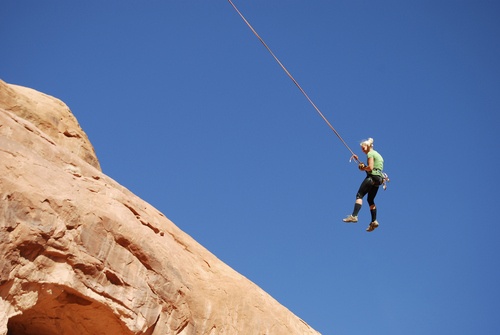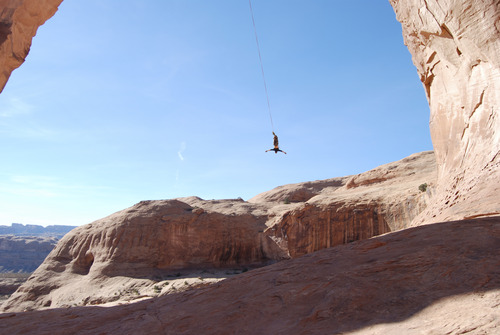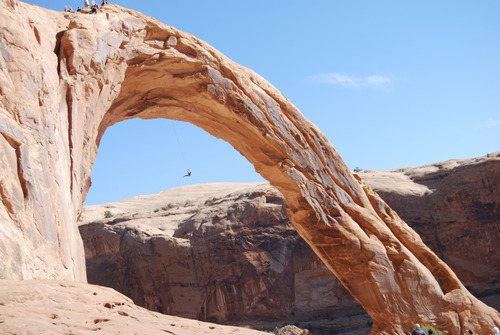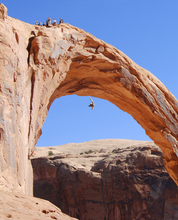This is an archived article that was published on sltrib.com in 2013, and information in the article may be outdated. It is provided only for personal research purposes and may not be reprinted.
Moab • It was fun while it lasted.
Something called the world's largest rope swing has liability written all over it, so it was probably only a matter of time before Utah state officials would put an end to commercial swinging on Corona Arch, made famous last year by YouTube videos that went viral.
On Jan. 17, the School and Institutional Trust Lands Administration (SITLA) informed an outfitter that it could no longer take paying clients to the arch, which remains open to private parties interested in climbing, rappelling and even swinging.
"If people want to huck themselves off a cliff or arch that's their business," said John Andrews, SITLA's general counsel. "There is a general principle that owners who hold their land open for recreational use are insulated from liability. We felt there was more risk [exposure to the state] if someone operated under a permit and someone got hurt."
Last year, Corona Arch became the site of "the granddaddy of all cheap thrills" after climbers adapted their gear to set up a rope with a 250-foot pendulum swing through the geological feature.
Jumper clients paid more than $200 each to Utah High Adventure last fall to swing under the arch, located on state land destined to be transferred to the federal government. The SITLA decision withdraws the parcel the arch occupies from commercially guided outdoor activities, according to Andrews.
"It's a bummer they closed it, but I can understand where they are coming from," said Thad James, owner of the Sandy-based outfitter that takes clients climbing, canyoneering and rafting in southern Utah. He remains concerned that amateur jumpers, drawn to the arch thanks to its newfound notoriety, may put themselves at risk.
"If you don't do it exactly right you can die," James said.
But liability wasn't the only concern for the state. Corona Arch is among the 46,000 acres of recreational land in San Juan, Grand and Uintah counties that SITLA intends to exchange for Bureau of Land Management land with mineral potential. Because the BLM may not be interested in continuing commercial arch swinging, the state felt it would not be appropriate to hand the feds a parcel encumbered with that use, according to Andrews.
Utah BLM officials said the agency would indeed re-examine any SITLA permits associated with rope swings. It has never been asked to permit commercial jumping from any of the hundreds of wind-sculpted arches and bridges it administers on public land.
That might be because Corona Arch appears to be unique, "custom made by God for jumping," according to James. It has a non-technical approach to the top, natural stairs step down to the jump-off spot and adjacent cliff faces angle away. It is also easy to get to. The site is a popular hiking destination — 1.5 miles up a slickrock trail from the Colorado River just west of Moab.
James' friend Brock Howell devised the swing with five anchor points and two ropes. At first Howell and James took friends jumping and interest in the adrenaline-fueled experience quickly soared, but doing it safely requires precision, experience and the right gear.
Anchors must be set just right or jumpers risk swinging into the far leg of the arch or back into the cliff. The swing angle should be offset 15 degrees, but not many thrill seekers know that, said James, who has heard from groups whose return swings come perilously close to the cliff face. And rope lengths need to be calibrated to safely navigate the 140-foot height of the arch.
Jumpers free fall for 130 feet before the rope becomes taut, swinging them just above the sandstone floor before soaring skyward through the arch. They enjoy six or seven swings before being lowered to the ground.
"When you come to your highest point you are 200 feet up because the ground falls away," James said. If a jumper's harness or carabiners fail at the far end of the swing, he could be catapulted hundreds of feet.
The potential for fatal accidents might seem large, but Utah High Adventure had no trouble expanding its existing insurance to cover the activity, James said. In the four months its SITLA permit allowed his company access to the arch, it took about 100 paying clients swinging without mishap.









